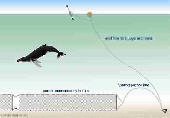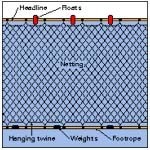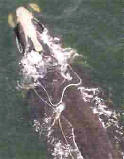|
Acoustically Reflective gill nets: Perhaps the most promising development to date has been the invention and development of the acoustically reflective gill nets. This gill nets was invented by a scientist in the US. It is heavier than a normal gill nets as it has barium sulphate filler. Fishermen are not required to attach anything. The unit is complete.
Trials in the Bay of Fundy (1998 & 2000) were very promising.
In his Report to ASCOBANS (27 -12 -2000), Dr. Andrew Read stated
"experimental trials indicated that acoustically reflective nets are effective in reducing the
bycatch of harbour porpoises in a statistically significant fashion.
In 1998 and 2000, 7 of 242 control strings, had at least one porpoise bycatch, whereas no
porpoises were taken in 124 strings of acoustically reflective gill nets.
In the Bay of Fundy tests, no significant difference was observed in the catch rate of target
species between control and acoustically reflective nets (Trippel 2000)."
Dr. Read continued, to state that the Scientific Committee of the IWC endorsed further
experimentation with these nets and that the
Gulf of Maine TRT, at its meeting in December 2000,
recommended that a large scale trial be conducted to
determine whether the acoustically reflective gill nets
would reduce the bycatch rates of harbour porpoises in
the groundfish sink gill nets fishery.
He also stated "If they prove to be effective in reducing
the bycatch of small cetaceans in gill nets fisheries, and do
not reduce the catch of target fish species, acoustically
reflective gill nets hold great promise as a mitigation measure".
In an article written by Gretel H. Schueller, (19 - 02 - 2001), Dr. E. Trippel -
Canadian Department of Fisheries and Oceans, is reported to have said that the
results involving the acoustically reflective nets "are almost to good to be true". In the same article, Dr. D. Potter, NMFS, is reported to have said, "If the net works as well as tests indicate, the net has the potential to be useful......it might turn out to be a global solution".
There was also a significant reduction in seabird bycatch, and anecdotal reports suggest that seals were not attracted to the nets. Pingers act as dinner bells to seals with obvious consequences.
Anecdotal reports also suggest that these nets could assist in
reducing dolphin bycatch, and trials will take place in the near
future in US waters.
Trials of acoustically reflective nets were carried out in Danish waters.
However, the filler used was iron oxide, as opposed to the barium sulphate, and the nets were not hung by an expert team.
Additional floatation should have been added to the nets, as they were 12% heavier than normal nets. This was not done and consequently, although the nets did not collapse towards the bottom, they did sag.
Even though the tests were not carried out as per instructions, the results regarding harbour porpoise bycatch were as promising as those in the Bay of Fundy, but there was a reduction in fish catch.
It is imperative that the barium sulphate filled acoustically reflective nets are tested in European waters.
|




